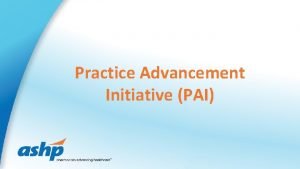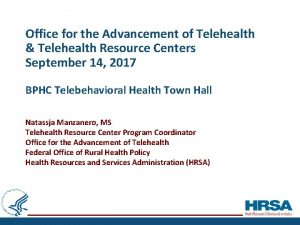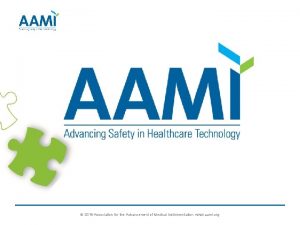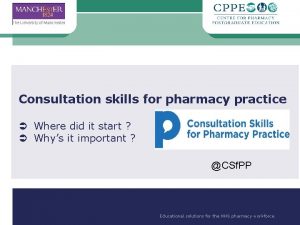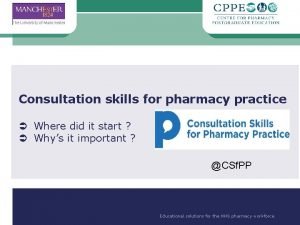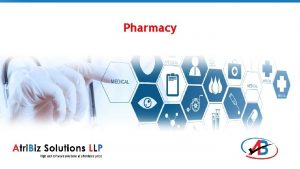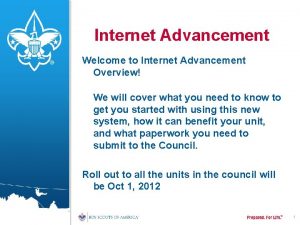Practice Advancement Initiative PAI Pharmacy Advancements 1960 Unit

























- Slides: 25

Practice Advancement Initiative (PAI)

Pharmacy Advancements 1960 Unit Dose 1980 s Discovery of anti‐ retrovirals 1987 Lovastatin approved 1990 Surfactant discovered 1990 s Monoclonal antibodies 2002 to 2012 Bedside barcoding 2. 5% to 65. 5% 2003 to 2012 CPOE 5. 9% to 54. 4%

What is PAI? • Joint initiative ❖ ASHP (American Society of Health‐System Pharmacists) ❖ ASHP Research & Education Foundation • Transforming how pharmacists care for patients ❖ Led by pharmacists ❖ Improve patient outcomes • Empowers pharmacists to integrate with the interprofessional healthcare team

PPMI to PAI • Pharmacy Practice Model Initiative (PPMI) ❖ A concept introduced that supports pharmacists’ roles as direct patient care providers in hospitals and health‐systems ❖ Started with an invitational summit in November 2010 • Ambulatory Care Summit held in March 2014 • In 2015, PPMI rebranded to PAI ❖ No longer limited to hospital settings ❖ Focus on acute and ambulatory care settings

PAI: The Journey to Improve Patient Care


Five Pillars of PAI 1. 2. 3. 4. 5. Care Team Integration Leveraging Pharmacy Technicians Pharmacist Credentialing and Training Technology Leadership in Medication Use

Goal of PAI “ To significantly advance patient health by developing and disseminating futuristic practice recommendations that support pharmacists’ roles as direct patient care providers. ”

PAI Rationale • • • Healthcare reform is a national priority Demand for higher quality and safer care at lower costs Health professional shortages Demographic, social, and economic influences Must develop future focused practices

PPMI Summit of 2010 • • Two‐day invitational event of pharmacy professionals Areas of consensus assessed prior to conference by survey Consensus process to develop optimal pharmacy practice model recommendations 147 recommendations adopted

PPMI Focus Areas • • • Create a Framework Determine Services Identify Emerging Technologies Develop a Template Implement Change

Key Recommendations: PPMI Summit • • • Right to receive a pharmacists' care Responsibility and accountability for patients’ medication‐ related outcomes Reallocate resources to devotemore pharmacist time to medication management services Certification and proper training through the appropriate board of pharmacy specialties Pharmacist‐provided drug therapy management, using a patient medication complexity index

Key Recommendations: PPMI Summit • • • Patient medication complexity index should be developed Accept responsibility for the clinical decisions and distribution of medications by the pharmacy department Resources to ensure technology‐related medication‐use safety standards Completion of accredited technician training program before certification examination Technicians must be licensed by state boards of pharmacy

Hospital Self-Assessment • Complete Hospital Self‐Assessment • Prepare Action Plan – identify priorities based on feasibility and impact • Consists of 106 questions designed to assess an individual hospital’s alignment with the recommendations • Covers a wide range of topics such as: ❖ Advancing the application of IT in the medication‐use process ❖ Advancing the use of Pharmacy Technicians ❖ Care team integration

Ambulatory Care Summit Goal of Ambulatory Care PAI is to: “ Create a long‐term vision for pharmacy practice models to ensure that pharmacists participate as members of the ambulatory health care team who are responsible and accountable for patient and population outcomes. ”

Key Recommendations: Ambulatory Care Defining Ambulatory Care Pharmacy Practice: • As members of the interprofessional patient care team, ambulatory care pharmacists would: v Perform patient assessments v Have prescribing authority to manage diseases through medication use v Provide collaborative drug therapy management • Patient Care Delivery and Integration v Encourage collaboration between the patient, caregivers, and healthcare professionals for seamless transitions across the continuum of care.

Key Recommendations: Ambulatory Care • Sustainable Business Models ❖ Pharmacists must be recognized as health care providers • • Section 1861 of the US Social Security Act must be amended States, healthcare payers, and other jurisdictions must also recognize pharmacists as providers • Outcomes Evaluation ❖ Demonstrate a measurable and meaningful impact • Must focus on individuals as well as overall population • Partner with patients and other members of the ambulatory interprofessional care team

Ambulatory Care Self-Assessment Tool • Tool developed by an expert panel ❖ Ensures practice aligns with recommendations from 2014 Ambulatory Care Summit ❖ Opportunity to develop an action plan after completing the Ambulatory Care Assessment ❖ Action plan focuses on individual practice priorities ❖ List of resources provided with action plan • Two versions of the self‐assessment (system and practitioner) • Opportunity to generate reports comparing their data with similar ambulatory settings within state and across the country

Collectively, the key recommendations from the PPMI and Ambulatory Care Summits lay the foundation for the Pharmacy Advancement Initiative

What you can do as a student • Spread the word about PAI ❖ Explain to others how PAI will shape the future of pharmacy ❖ Share with healthcare providers ❖ Present on PAI at your work, rotation site, or SSHP meeting • Bring PAI to the state level ❖ Task force ❖ Educational opportunities ❖ Projects

What you can do as a student • Encourage completion of self‐assessments (hosptial and ambulatory care) at your rotation sites! • Ask how YOU can contribute to or take on a project related to the self‐assessment action plan • Safety and quality in the medication‐use process v. Audit and evaluate processes on your health‐system rotation v. Improve patient interview skills

What you can do as a student • • Schedule PAI events for ASHP PAI week to raise awareness Participate in ASHP Connect PAI community Attend ASHP Midyear or Summer Meetings and participate in PAI and/or practice change sessions Participate in advocacy efforts for provider status at the state and national level

SSHP PAI Task Force Collaborate with your state organization’s PAI Task Force to develop working groups: v Hospital Self‐Assessment (HSA) outreach v Practice Advancement Tool Kits v Ambulatory Care PAI outreach

Tools & Resources For more information, visit: What you’ll find: v v v ASHP-PAI Online! More information about PAI Tools, resources, and recommendations Progress measures for tracking PAI progress Web‐based hospital self‐assessment Web‐based ambulatory care self assessment C‐Suite Resources

For more information on this initiative, please contact: Kelsea Seago (kbfickiesen@mix. wvu. edu) Workgroup Lead, ASHP Pharmacy Student Forum Advancement of Pharmacy Practice Advisory Group Evan Colmenares (evan_colmenares@unc. edu) Chair, ASHP Pharmacy Student Forum Advancement of Pharmacy Practice Advisory Group Kristy Nguyen (kristy. nguyen@wne. edu) Executive Committee Liaison, ASHP Pharmacy Student Forum Advancement of Pharmacy Practice Advisory Group Diana Dabdub (students@ashp. org) Director, ASHP Pharmacy Student Forum
 Practice advancement initiative
Practice advancement initiative Advancements in solar energy
Advancements in solar energy Tbnow
Tbnow Goodsalls rule
Goodsalls rule Casis
Casis Wiberg patella
Wiberg patella Advancement office structure
Advancement office structure Office for the advancement of telehealth
Office for the advancement of telehealth Holistic advancement meaning
Holistic advancement meaning Holistic advancement meaning
Holistic advancement meaning Uf advancement
Uf advancement Advancement in medicine
Advancement in medicine Vowel classification
Vowel classification Professional advancement in nursing
Professional advancement in nursing Fistulectomy
Fistulectomy Dental hygienist advancement opportunities
Dental hygienist advancement opportunities Association for the advancement of medical instrumentation
Association for the advancement of medical instrumentation Center for additive technology advancement
Center for additive technology advancement Scoutbook advancement sync
Scoutbook advancement sync National technology transfer
National technology transfer Daf yomi advancement forum
Daf yomi advancement forum Action for social advancement (asa)
Action for social advancement (asa) Consultation skills for pharmacy practice
Consultation skills for pharmacy practice Ratio strength formula
Ratio strength formula Peter bai
Peter bai Consultation skills for pharmacy practice
Consultation skills for pharmacy practice
